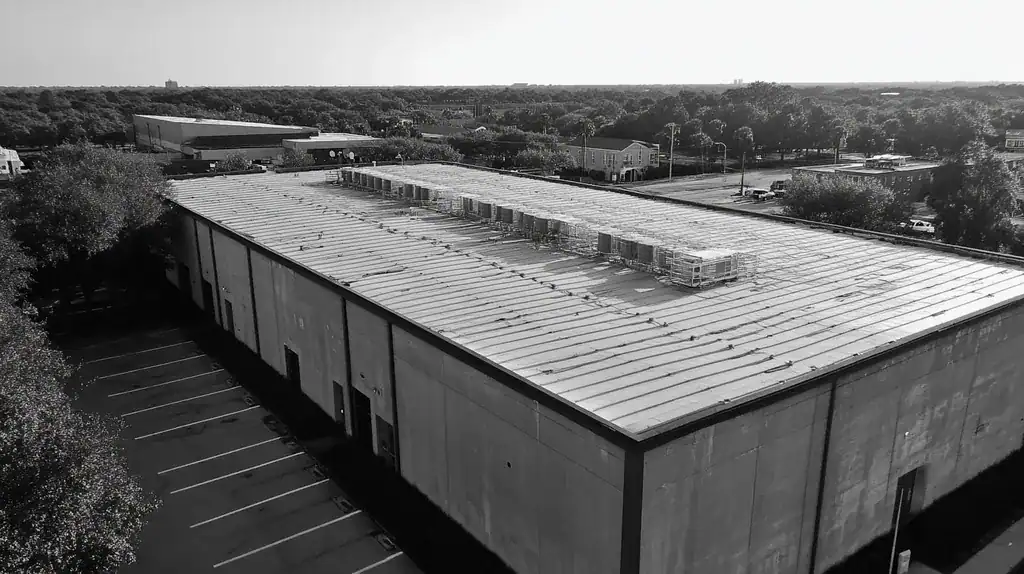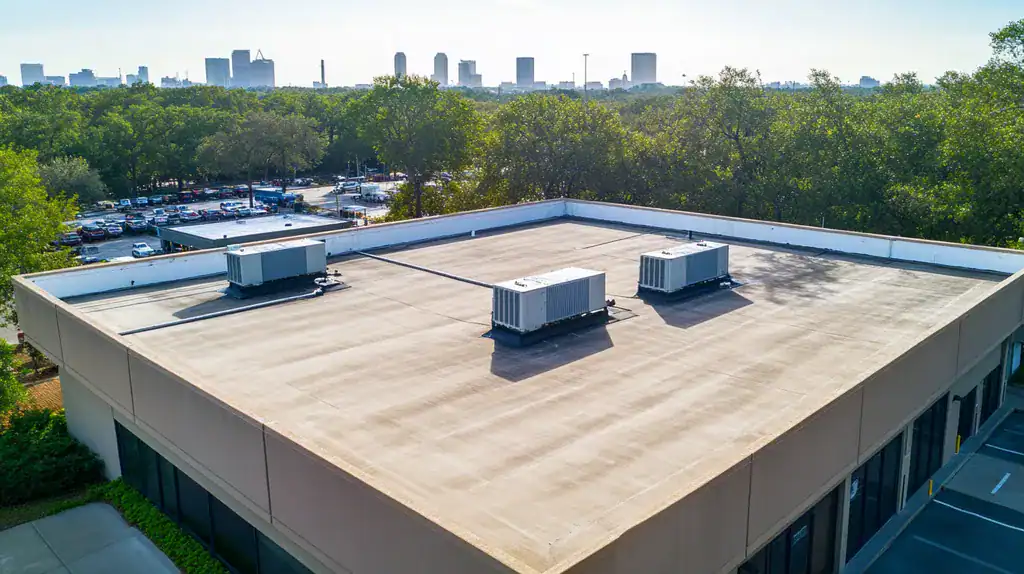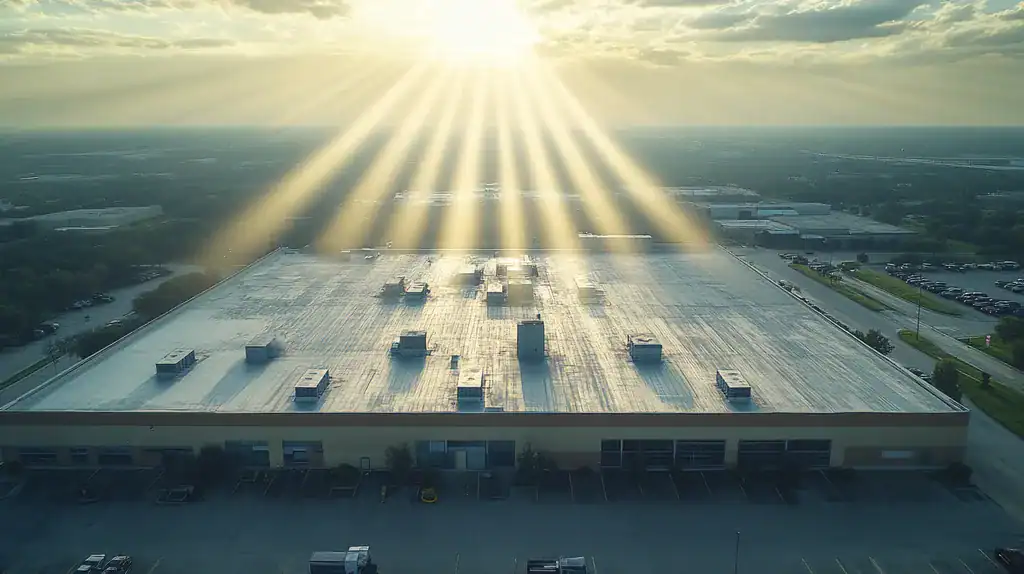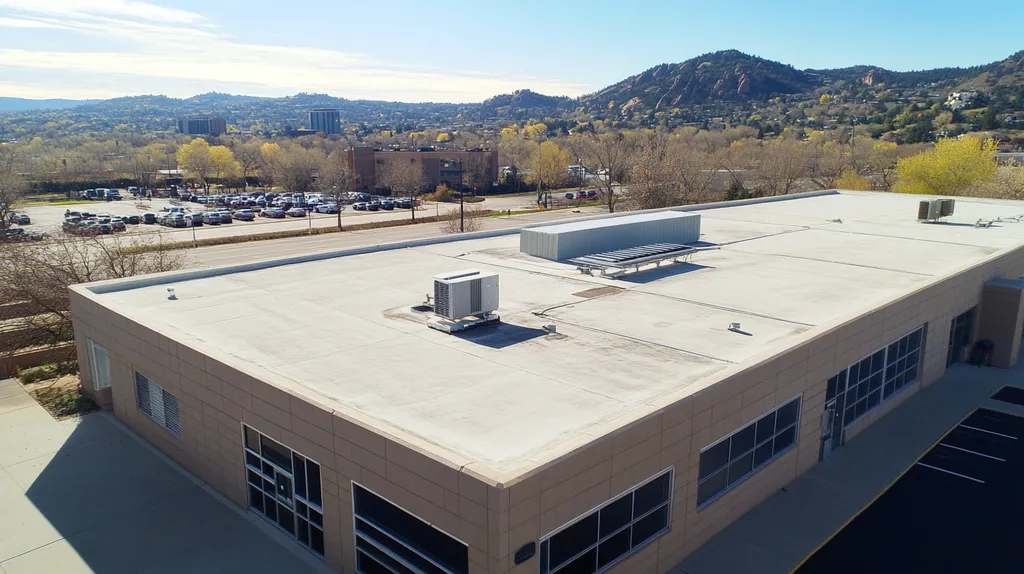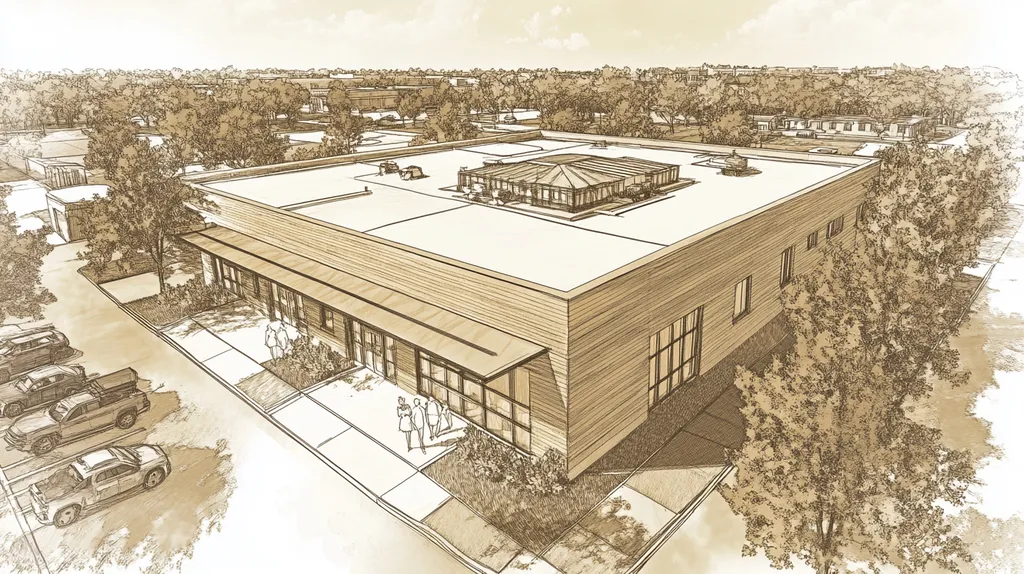Climate-related roof coating failures cost U.S. businesses over $1.2 billion annually, with 73% of these failures stemming from mismatched coating selections for local weather conditions.
As extreme weather events become more frequent and severe, understanding how climate affects commercial roof coatings has evolved from a maintenance concern into a critical business continuity issue.
This comprehensive guide examines the fundamental relationships between climate conditions and coating performance, exploring everything from material selection to implementation strategies that protect commercial roofing investments.
SECTION 1: FUNDAMENTAL CONCEPTS
In today’s evolving climate landscape, roof coatings face unprecedented challenges. Industry data shows that 40% of commercial roof coating failures occur due to mismatched coating selections for local weather conditions. With extreme weather events becoming more frequent and severe, understanding how climate affects roof coatings isn’t just about maintenance—it’s about protecting significant capital investments and ensuring business continuity.
Understanding Roof Coating Fundamentals
Roof coatings form a crucial protective layer that shields commercial buildings from environmental stresses. These specialized materials create a seamless, waterproof barrier that defends against UV radiation, precipitation, and temperature fluctuations.
The effectiveness of a coating system depends heavily on proper material selection and application timing. Even minor mistakes during installation can compromise the entire system, leading to premature aging and reduced performance.
A cool roof coating system absorbs and transfers less heat from the sun compared to conventional roofing materials, significantly reducing cooling costs and urban heat island effects. (source: US Environmental Protection Agency)
Key Climate Factors Impacting Roof Coatings
Temperature fluctuation represents one of the most significant challenges for roof coating performance. Daily and seasonal temperature swings cause repeated expansion and contraction, testing the coating’s elasticity and adhesion properties.
Moisture penetration poses another critical threat to coating integrity. High humidity levels can prevent proper curing during application, while prolonged exposure to standing water can degrade even properly cured coatings.
Solar radiation intensity directly affects coating longevity. Areas with high UV exposure require specialized formulations with enhanced radiation resistance and reflective properties.
Common Failure Modes in Adverse Weather
Delamination frequently occurs when moisture becomes trapped between the coating and substrate. This condition typically develops during periods of high humidity or after extended rainfall events.
Surface crazing and cracking emerge when coatings experience rapid temperature changes. These defects often start microscopically but quickly develop into visible damage patterns.
Coating erosion accelerates in areas with high precipitation or frequent storms. Wind-driven rain and hail can gradually wear away the protective properties of the coating, leading to system failure.
Ponding water creates conditions for biological growth and chemical degradation. Extended contact with standing water can break down even the most robust coating systems over time.
SECTION 2: SYSTEM COMPONENTS
Commercial roofing failures cost businesses millions annually, with 35% of these failures traced to inadequate component selection for local climate conditions. Modern roofing systems require precise integration of materials, coatings, and structural elements to withstand increasingly severe weather patterns. Understanding these components helps property owners make informed decisions that protect their investments and avoid costly premature replacements.
Core Materials: Membranes, Polymers, and Additives
Modern commercial roofing depends on high-performance membranes that form the primary defense against environmental threats. Single-ply membranes like TPO and EPDM dominate the market, offering excellent resistance to UV radiation and temperature fluctuations.
Advanced polymer formulations enhance membrane flexibility and durability, crucial for regions experiencing extreme temperature swings. These materials maintain their protective properties even under severe thermal stress, preventing cracks and splits.
Specialized additives boost resistance to specific environmental challenges. Fire retardants, biocides, and UV stabilizers extend system longevity and improve performance in challenging climates.
Quality control during manufacturing ensures consistent material properties. Regular testing validates membrane thickness, polymer distribution, and additive concentrations meet specifications.
Reflective Coatings and UV-Resistant Layers
Reflective coatings serve as the first line of defense against solar radiation and heat buildup. White and light-colored surfaces significantly reduce roof temperatures, decreasing cooling costs and extending membrane life.
UV-resistant layers protect underlying materials from solar degradation. These specialized compounds prevent premature aging and maintain coating flexibility throughout the system’s service life.
Performance coatings require careful selection based on local climate patterns. High-altitude locations need enhanced UV protection, while coastal areas demand superior moisture resistance.
Regular recoating maintains optimal performance. Most systems require inspection and potential reapplication every 5-7 years, depending on exposure conditions.
Seams, Fasteners, and Waterproofing Features
Seam integrity determines overall system performance. Modern heat-welding techniques create molecular bonds stronger than the original membrane material, virtually eliminating weak points.
Mechanical fasteners must match both the roofing system and expected wind loads. Corrosion-resistant materials prevent degradation in harsh environments, maintaining long-term structural integrity.
Waterproofing details around penetrations require special attention. Pre-manufactured boots and custom-fabricated flashings protect vulnerable areas from water infiltration.
Quality installation significantly impacts component performance. Certified contractors follow manufacturer specifications for seaming temperatures, fastener patterns, and detail work.
Advanced waterproofing technologies create seamless protection across the entire roof surface. Self-adhering membranes and liquid-applied systems eliminate traditional weak points while providing superior weather resistance.
SECTION 3: IMPLEMENTATION METHODS
Proper implementation of roof coatings can mean the difference between a system that lasts 20+ years and one that fails within months. Industry data shows that 65% of premature coating failures stem from improper installation practices rather than material defects. With modern coating systems costing $6-12 per square foot, implementation errors can result in hundreds of thousands in unnecessary expenses for large commercial facilities.
Surface Preparation and Contamination Control
Surface preparation represents the most critical yet often overlooked phase of coating installation. Thorough cleaning must remove not just visible debris, but microscopic contaminants that can prevent proper adhesion.
Different roofing substrates require specific preparation protocols. Metal roofs need degreasing and rust removal, while single-ply membranes require special cleaning agents to avoid material degradation.
Environmental conditions during preparation significantly impact success rates. High humidity can trap moisture in the substrate, while extreme heat can cause cleaning solutions to evaporate too quickly.
Quality control testing during preparation helps verify surface readiness. Adhesion tests, moisture readings, and pH measurements provide objective data to guide the next steps.
Application Techniques for Different Climates
Application methods must adapt to local weather patterns and seasonal changes. Hot climates require early morning or evening application to prevent flash-curing, while cold regions need supplemental heating to maintain proper material viscosity.
Wind conditions drastically affect sprayed applications. Speeds above 10 mph can cause overspray issues and uneven coverage, requiring alternative application methods or temporary wind screens.
Humidity control becomes essential in coastal and tropical regions. Dehumidification equipment may be necessary to maintain proper curing conditions, especially during monsoon seasons.
Application thickness must account for local weather exposure. Areas with severe UV exposure or frequent storms require additional millage to ensure adequate protection.
Testing and Quality Assurance During Installation
Continuous monitoring throughout installation ensures proper coating performance. Wet film thickness gauges verify adequate material application, while infrared scanning can detect moisture trapped beneath the coating.
Regular adhesion testing validates proper curing progress. Pull tests at strategic intervals confirm the coating is developing proper bond strength with the substrate.
Environmental monitoring helps maintain optimal application conditions. Temperature, humidity, and dew point measurements guide work scheduling and equipment adjustments.
Documentation of testing results creates an audit trail for warranty compliance. Detailed records protect both contractor and property owner while establishing benchmarks for future maintenance.
SECTION 4: MAINTENANCE REQUIREMENTS
Regular maintenance stands as the cornerstone of commercial roof longevity, yet statistics show that 85% of premature roof failures stem from inadequate upkeep protocols. With replacement costs averaging $10-15 per square foot, neglecting maintenance can transform a manageable expense into a major capital burden. Modern coating systems demand structured inspection programs and rapid response capabilities to deliver their promised performance and lifespan.
Routine Inspections and Visual Assessments
Comprehensive inspection programs require systematic evaluation of all roof areas at least quarterly. These assessments must examine coating integrity, seam conditions, and drainage functionality to identify emerging issues before they escalate.
Documentation through detailed checklists and photo records creates accountability and tracking capabilities. This data helps identify wear patterns and predict maintenance needs before critical failures occur.
Surface reflectivity testing provides crucial performance metrics for cool roof systems. Regular cleaning and maintenance of reflective surfaces helps maintain energy efficiency benefits and extends coating longevity.
Thermal imaging during inspections can detect hidden moisture infiltration that visual checks might miss. Early detection of subsurface issues prevents extensive damage to insulation and deck materials.
Detecting and Addressing Minor Deficiencies
Small coating breaches require immediate attention to prevent water infiltration and coating delamination. Even pinhole-sized defects can channel significant moisture into the roofing system over time.
Regular adhesion testing around penetrations and high-stress areas helps identify potential failure points. This proactive approach allows for targeted repairs before widespread damage occurs.
Sealant deterioration often precedes major leaks, particularly around roof penetrations and equipment curbs. Annual replacement of degraded sealants prevents moisture intrusion at these vulnerable points.
Drainage system maintenance prevents ponding water that can degrade coating performance. Regular clearing of drains, scuppers, and gutters protects the entire roofing system from water damage.
Response Plans for Extreme Weather Events
Pre-storm preparation protocols should include securing loose materials and inspecting drainage systems. Having emergency repair materials on hand enables rapid response when damage occurs.
Post-storm assessment procedures must systematically document all damage through detailed photography and mapping. This documentation supports insurance claims while ensuring repairs address all affected areas.
Emergency repair strategies should prioritize preventing additional damage over permanent fixes. Temporary patches and water diversion methods protect building contents until permanent repairs can be completed.
Recovery plans must address both immediate damage and long-term preventive measures. Analyzing failure patterns helps improve system resilience against future weather events.
SECTION 5: PERFORMANCE METRICS
Accurate performance metrics stand as the cornerstone of effective commercial roof management, yet 70% of buildings lack proper measurement protocols. This oversight costs U.S. businesses over $3.3 billion annually in premature roof failures and excess energy consumption. With increasingly extreme weather patterns, understanding and tracking key metrics has become essential for protecting commercial roofing investments and maintaining operational efficiency.
Measuring Reflectivity and Solar Reflectance Index
Solar reflectance capabilities directly impact building energy efficiency and coating longevity. Modern reflective coatings can reduce peak roof temperatures by up to 50°F, translating to 10-30% reductions in cooling costs.
The Solar Reflectance Index (SRI) provides a standardized measurement of a roof’s ability to reject solar heat. Higher SRI values indicate better performance, with premium coatings achieving ratings above 100.
Regular reflectivity testing reveals coating degradation before visible signs appear. Annual measurements help facility managers optimize recoating schedules and maintain energy efficiency benefits.
Environmental factors like air pollution and biological growth can significantly reduce reflective performance. Establishing baseline measurements and tracking changes over time enables data-driven maintenance decisions.
Evaluating Water Resistance and Leak Prevention
Water resistance testing identifies vulnerabilities before leaks develop. Standard methods include electronic leak detection, flood testing, and adhesion pull tests to verify coating integrity.
Hydrostatic pressure measurements around drains and penetrations reveal potential failure points. These critical areas typically show the first signs of water infiltration and require enhanced monitoring.
Modern moisture mapping technology detects subsurface water accumulation non-invasively. This capability allows facility managers to address moisture issues before they compromise insulation or deck materials.
Systematic documentation of water resistance metrics creates trend data for predictive maintenance. Understanding deterioration patterns helps optimize repair timing and preserve coating performance.
Assessing Durability and Material Longevity
Physical durability measurements quantify a coating’s resistance to weathering and mechanical stress. Key indicators include elongation properties, tensile strength, and resistance to impact damage.
Accelerated aging tests predict long-term performance under various climate conditions. These standardized procedures expose coatings to concentrated UV radiation, temperature cycling, and chemical exposure.
Chemical resistance testing evaluates coating stability against environmental pollutants. Areas with high industrial emissions or salt exposure require enhanced chemical durability properties.
Service life projections based on durability metrics guide capital planning decisions. Accurate lifespan estimates help facility managers budget for maintenance and eventual replacement costs.
SECTION 6: OPTIMIZATION STRATEGIES
Optimizing roof coating performance has become critical as weather patterns grow increasingly extreme. Industry data shows that poorly optimized coating systems fail 3-5 years earlier than properly configured ones, while well-optimized systems can extend roof life by up to 15 years. With coating and installation costs averaging $8-12 per square foot, optimization strategies directly impact both building performance and bottom-line profitability.
Selecting Coatings for Regional Climate Conditions
Regional climate patterns should drive coating selection decisions. High-temperature regions require coatings with superior UV resistance and thermal stability, while coastal areas need enhanced protection against salt spray and humidity.
Seasonal weather variations demand careful consideration of coating flexibility ranges. Systems must maintain adhesion and elasticity through both summer heat and winter freeze-thaw cycles to prevent premature failure.
Local precipitation patterns influence water resistance requirements. Areas with frequent rainfall need coatings with superior hydrophobic properties, while regions prone to hail require enhanced impact resistance.
Wind exposure levels determine necessary coating thickness and attachment methods. Buildings in high-wind zones need thicker applications and may require mechanical reinforcement to prevent coating separation.
Enhancing Energy Efficiency and Thermal Performance
Cool roof coatings provide significant energy savings through enhanced solar reflection, reducing cooling costs and urban heat island effects. These specialized coatings can lower peak roof temperatures by up to 50°F while decreasing greenhouse gas emissions from air conditioning systems. (source: US Environmental Protection Agency)
Thermal imaging analysis helps identify areas of heat gain and loss. Regular scanning allows facility managers to target problem areas and optimize coating applications for maximum energy efficiency.
Insulation coordination with coating systems maximizes thermal performance. Proper integration ensures consistent temperature control while preventing condensation issues that could compromise coating adhesion.
Performance monitoring through utility tracking validates energy improvements. Documentation of reduced HVAC loads helps justify coating investments and guides future optimization efforts.
Proactive Upgrades and Technological Advancements
Smart coating systems with embedded sensors now enable real-time performance monitoring. These technologies track temperature, moisture levels, and coating integrity, allowing for predictive maintenance before problems develop.
Nano-engineered coating materials offer unprecedented durability and performance. Latest-generation products provide self-cleaning properties and enhanced resistance to environmental stressors.
Automated application systems improve coating consistency and thickness control. Robotic sprayers and computer-controlled dispensing equipment minimize human error while maximizing coverage uniformity.
Integration with building management systems optimizes coating performance through automated responses to changing conditions. Smart controls adjust ventilation and cooling systems based on real-time roof coating performance data.
Looking Ahead
With climate-related coating failures costing businesses over $1.2 billion annually, the stakes for proper system selection and maintenance have never been higher.
As extreme weather events continue increasing in both frequency and intensity, coating performance has become a critical factor in building resilience and operational continuity.
The data shows that properly selected and maintained roof coatings can extend system life by 15-20 years while reducing cooling costs by up to 30%.
Success requires an integrated approach: climate-appropriate material selection, meticulous installation practices, proactive maintenance protocols, and regular performance monitoring.
Facilities that implement comprehensive coating strategies now will be best positioned to weather the environmental challenges ahead while protecting their roofing investments.
FREQUENTLY ASKED QUESTIONS
Q. How do climate conditions affect commercial roofs?
A. Climate conditions, such as temperature fluctuations and moisture, significantly influence roofing performance. These factors impact adhesion and longevity, potentially leading to premature failure if not addressed properly.
Q. What are essential components for an industrial roof in extreme climates?
A. Key components include high-performance membranes, additives, and waterproofing features. Ensuring proper integration and selection based on local conditions is critical for durability and performance.
Q. What practices ensure proper installation of a commercial roof coating?
A. Practices include thorough surface preparation, appropriate application methods, and constant quality testing. Proper training and attention to environmental conditions during installation are essential to prevent failures.
Q. How often should I maintain my commercial roof?
A. Regular inspections at least quarterly are vital to maintain a commercial roof. This routine helps catch emerging issues early and extends the roof’s lifespan through proactive maintenance.
Q. What performance metrics should I track for my industrial roof?
A. Key metrics include solar reflectance, waterproofing integrity, and durability against weathering. Tracking these helps forecast maintenance needs and prevents early failures from unforeseen factors.
Q. How can I optimize a commercial roof coating’s performance?
A. Optimization can be achieved by selecting appropriate coatings for regional climate and enhancing energy efficiency. Regular monitoring and timely upgrades ensure maximum performance and longevity.
Q. What are common roofing issues during extreme weather events?
A. Common issues include coating degradation from UV exposure and damage from heavy rain or wind. Proactive maintenance and preparation can minimize these impacts and extend roof longevity.

